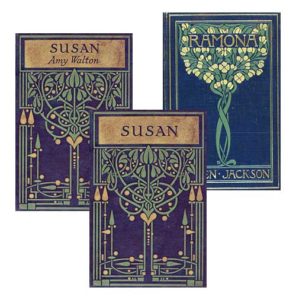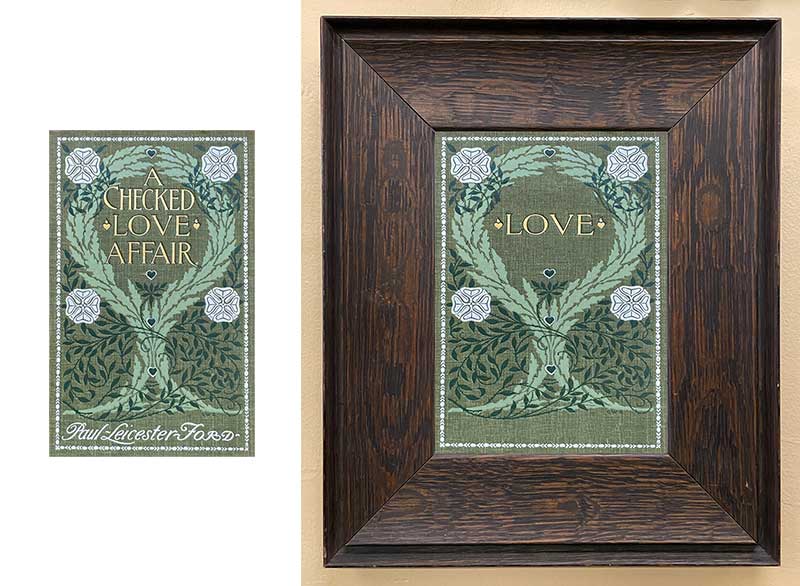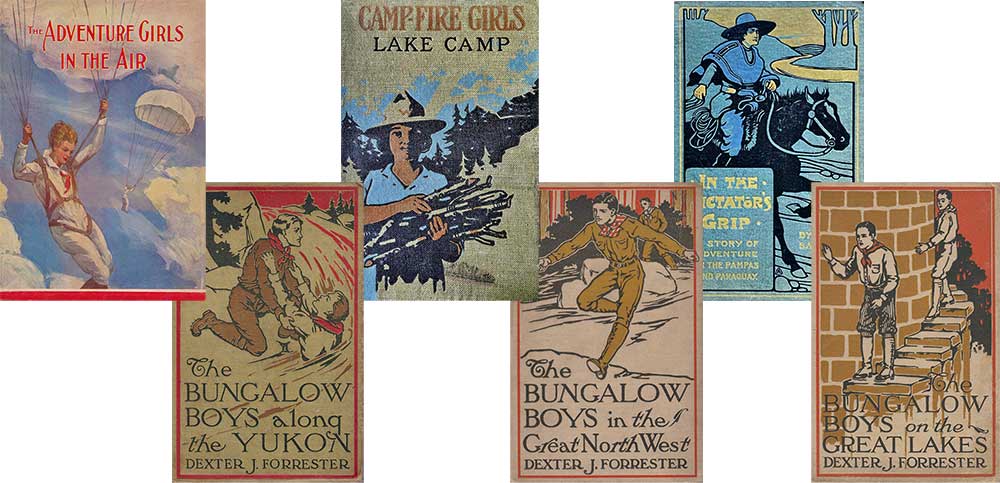Small Home Gazette, Winter 2021
Book Cover Art for Your Bungalow
 Now that cold weather has arrived and the coronavirus continues to stalk the land, it is a good time for a stay-at-home project.
Now that cold weather has arrived and the coronavirus continues to stalk the land, it is a good time for a stay-at-home project.
Bungalow Club member Larry Crawford recently shared his success in turning early 20th century book cover illustrations into frameable art. Here is how to do it.
Find Book Covers Worthy of Framing
Let us be honest—the content of most novels from a century ago have not held up well. Shortly after moving into my bungalow, I read the Nancy Drew novel, The Bungalow Mystery. The story was rather thin, to put it gently. But the illustrations on the covers of even the weakest texts can sometimes be delightful.
You may already own books with beautiful covers, though they may be hidden on a bookshelf. Look through your collection for those that would brighten your walls.

Club member Larry Crawford liked the mountainous graphic on this book cover (left) but found the words distracting. He scanned the cover and digitally removed the text; then had a quarter-sawn oak frame custom-built for the final image.
Another option is a visit to used book stores and antiques shops. You can also find vintage books for sale online, though conducting a search that prioritizes cover illustrations is much harder than searching for book titles or content.
Finally, you might try an internet search using phrases such as “arts and crafts book cover,” or “art nouveau book cover.” Filter the results using the “images” option. Unfortunately, though you will find many beautiful examples, the digital file sizes of these covers are usually far too small to reproduce with enough detail for framing.
Convert the Cover to a Digital Image
Once you have found a suitable specimen, you will need to create a digital image of it, typically by making a scan or taking a photograph. Of course, you can always remove the actual cover from the book, but I think it is a shame to destroy an intact book even if the content is of no interest.
Many home printers include a flatbed scanner. To get the sharpest image, use a scan resolution of 600 dpi. If you photograph the cover, make sure it is brightly and evenly lit, preferably with natural daylight. And do your best to photograph it directly head-on so that there is no perspective skew. An out-of-square image will cause problems when it comes to framing.
Edit the Image
 There is nothing wrong with framing an image that is obviously a book cover. Present the cover just as it is, including the title and author’s name. After all, some titles and names are quite evocative, and some are well-integrated into the overall design.
There is nothing wrong with framing an image that is obviously a book cover. Present the cover just as it is, including the title and author’s name. After all, some titles and names are quite evocative, and some are well-integrated into the overall design.
But you may just want the design element without the distraction of text. If so, you will need a computer and image-editing software to digitally remove the unwanted elements. At the same time, you can spruce up the image by “repairing” scuffs and scratches on the original cover.

You may be lucky enough to find a book with your name (or the name of someone you know) in the title. Using an image editor for fine tuning, you could create an elegant tribute.
When it comes to image editing software, Adobe Photoshop holds the dominant mindshare. But unless you already have Photoshop, there is no need to spend hundreds of dollars on a program that is designed for professionals and can be overwhelmingly complex to use. Fortunately, consumer-oriented programs are more affordable and user-friendly. There are too many to attempt a list here, but when shopping, you should look for these image editing features:
- A “healing” tool, which automatically erases unwanted details in the image by sampling the area around them.
- A “clone” tool, with which you can eliminate unwanted elements by replacing them with portions copied from another area of the image.
- The ability to skew the image’s perspective. This function is helpful for truing the sides of an image so they are at right angles to each other. It also enables you to slightly squeeze or stretch the dimensions of an image so that it will better fit an existing frame.
If you do not have the equipment or the technical skills to edit the image yourself, reach out to a “techie” friend or family member who might be willing to help.
Frame the Image

Most of this book’s title and the author’s name (left) were removed to create the final image (right). Notice that the book’s proportions were also digitally altered so that the print fits the dimensions of the vintage frame.
You will need a frame to display your book cover art. Book cover dimensions vary widely, as do picture frames, and the chances of stumbling upon a perfect match are small. If you already have a frame that is close to the correct size, you may be able to tweak the height or width of the book cover image before printing it. (Always print your image using the highest quality settings on your printer and use paper specifically designed for professional photos.)
You might also choose to have a new frame made to the exact measurements of the cover. Your neighborhood frame shop can do this, and though it might not be the cheapest option, local businesses will appreciate your business.
Another option is to order a custom frame online. A quick internet search will provide links to companies offering thousands of options, from the cheapest plastic to quarter-sawn oak to ornate, gilt masterpieces.
 Interested in a deeper dive into cover art? Check out Arts and Crafts Book Covers, a 120-page softcover publication that highlights prominent book cover artists from the British Arts & Crafts movement during the late 19th and early 20th centuries. Contains 99 color images of gorgeous covers. Purchase a copy online.
Interested in a deeper dive into cover art? Check out Arts and Crafts Book Covers, a 120-page softcover publication that highlights prominent book cover artists from the British Arts & Crafts movement during the late 19th and early 20th centuries. Contains 99 color images of gorgeous covers. Purchase a copy online.












